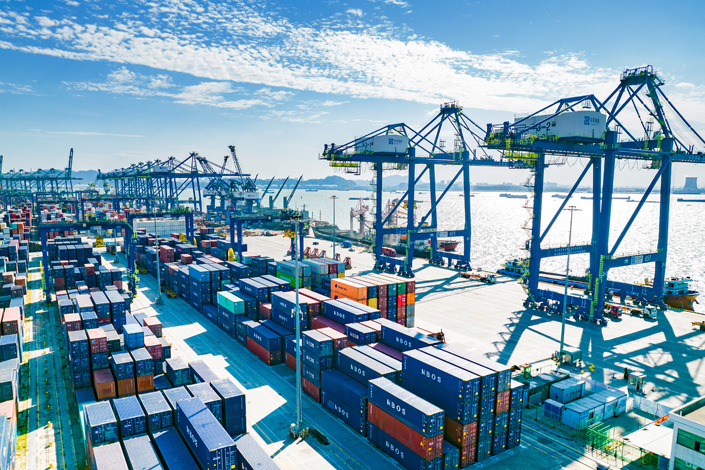
Markets have been expecting a new round of stimulus plans since “stability” was flagged as the paramount goal in 2022 during the Central Economic Work Conference in December. In this article, I will discuss the policies that have been introduced or are likely to be rolled out this year.
China’s central bank will clearly move toward easing monetary policy. Since December, banks’ reserve requirement ratio has been cut once, and the one-year loan prime rate has been lowered twice. From October to January, monthly new total social financing (TSF) all grew year-on-year, reversing the declining trend in previous months. The central bank will have room to adopt a relatively loose monetary policy to stabilize the economy given the nation’s consumer inflation is still at a manageable level.
China’s monetary policy was relatively loose in 2007, 2012 and 2017, when the National Congress of the ruling Communist Party was held. The proportion of new TSF in GDP in each of the three years was much higher than that of its previous year. The proportion was 27.4% in 2021, closing to the average over the past decade. Yet it was lower than 34.3% in the fourth quarter of 2020, when the central bank started to soak up liquidity injected at the beginning of that year to cope with the Covid pandemic. The figure in 2022, the year of the party’s 20th National Congress, will be likely above the average level of the past decade, with liquidity gradually easing.
Bonds issuance was a major source of medium- and long-term funds, according to central bank data from the past few months. Meanwhile, medium- and long-term loans to both businesses and individuals remained on a relatively low level. Therefore, the biggest beneficiaries of this round of easing could be infrastructure investments and large industrial projects backed by government policies.
In the past months, infrastructure investment growth has been quite weak, though it has been showing signs of bottoming out. From the local government angle, the expectations of revenue from land sales are not promising for 2022, which will be a negative factor for infrastructure financing. Thus, it is likely that China’s infrastructure investment will witness a feeble recovery with single-digit growth.
As the central government reiterated its stance that “housing is for living in and not speculation,” a recovery of the real estate sector will be heavily dependent on one of the following: residents will be able to obtain mortgage loans more easily if they make purchases for living in; property developers will be allowed to use presale funds more freely on the premise that they will not leave any property project incomplete; some cities will be allowed to relax restrictions on property sales when conditions are met. That said, both rising home prices and a stronger sector across the board are not encouraged by the central government at the moment.
China’s low birthrate for years has taken a toll on housing demand, too. The number of marriageable people fell from 440 million in 2010 to 390 million in 2020. The United Nations forecasts that it will be less than 350 million by 2030.
Slowing urbanization rates are also a constraint for housing demand. In 2016, China’s urban population grew by more than 26 million. In 2021, the increase was only slightly over 12 million. Of course, the decline of the number after 2020 was probably driven by the pandemic. However, after more than 20 years of rapid development, people who are able to leave rural areas for urban areas have nearly achieved their goals, and it is difficult to expect that the country’s urban areas will face another big influx of migrants. That is to say, investment in China’s property sector will slow or even shrink.
Encouraging consumption growth and upgrading should be an important pillar in promoting China’s domestic economy. Still, there hasn’t been any new related policy launched yet. This is not a big surprise. It is hard to give a big boost to consumption if China doesn’t relax its anti-epidemic rules. We can’t expect the authorities to relax the rules substantially when the outbreaks haven’t been contained and given that there will be multiple tasks that need to get done in the year ahead.
The way things are, exports and manufacturing investments will be China’s economic bright spots in 2022. The nation’s exports will continue the growth trend in 2021. As its performance depends on global economic growth, there’s not much the Chinese government can do. Homegrown innovation and import substitution will be the main drivers of manufacturing investments; China has long been working on the two areas, which could get a boost at a time when the government needs to ease policies to stabilize economic growth.
All in all, China’s GDP growth in 2022 will still be slow even if the government is willing to stabilize the economy and relax its economic policies. The deciding factor for growth will hinge on whether a rebound in infrastructure and manufacturing investments can offset the negative effects from the real estate and consumption sectors.
Vincent Chan is a China strategist at investment advisory firm Aletheia Capital.
This article has been edited for length and clarity.
The views and opinions expressed in this opinion section are those of the authors and do not necessarily reflect the editorial positions of Caixin Media.
If you would like to write an opinion for Caixin Global, please send your ideas or finished opinions to our email: opinionen@caixin.com
Contact translator Guo Xin (xinguo@caixin.com)
Get our weekly free Must-Read newsletter.







